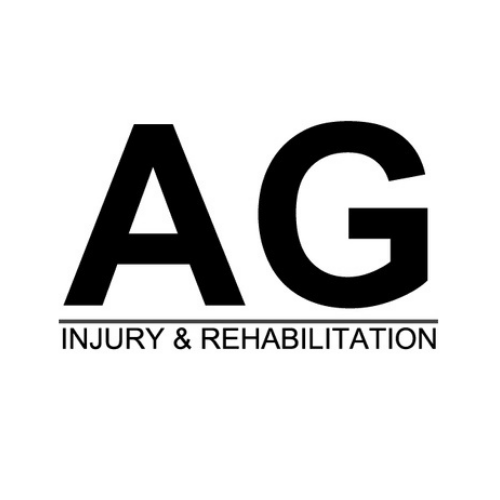Ankle pain can be both infuriating and immobilising. Anyone can suffer from an ankle injury at any point, even by doing something as simple as cleaning the house, using the stairs or walking the dog. Below, we have outlined the most common ankle injuries, what they are and what you can do to manage your pain.
So here are the most common ankle injuries:
- Achilles Tendinopathy
- Lateral Ankle Sprain
- Plantar Fasciitis
- Ankle Injury Requiring Surgery
Below, we delve into more detail about the four conditions above.
1. Achilles Tendinopathy

An Achilles Tendinopathy is an overuse injury. It tends to occur as a reaction to an increased demand on the tendon, beyond its capabilities. Those with an Achilles Tendinopathy will typically report pain and stiffness, which may reduce in the short term with brief, gentle movement.
The Achilles Tendon lies at the back of your ankle. It is a thick, fibrous tissue that attaches your calf muscle to your heel. The function of the tendon is to transmit the forces of the calf muscle to your foot, allowing you to do movements such as point your toes, run and jump.
Those who have recently become more active, such as taking up jogging or a jumping sport, can commonly encounter an Achilles Tendinopathy. A change of footwear, particularly to unsupportive flat shoes, can also trigger the condition.
The pain tends to increase when a load is placed through the tendon after periods of immobility, such as first thing in the morning or stepping out of the car after a long drive.
Treating an Achilles tendinopathy yourself is very simple, but you have to be patient and strict with your regime. First and foremost, you must reduce the activities that irritate your tendon. If stress continues to be places on the tissues, the tendon will become more and more irritated. Substitute weight bearing sport for activities such as swimming and cycling to maintain your fitness. Wear shoes that support the inner arch of your foot, ensuring you tie your laces securely.
Improving blood flow to the area can help to stimulate the healing process. Place a hot water bottle over your Achilles Tendon to reduce the stiffness you feel when the tendon has not been used for some time.
Massaging around the tendon can also help with circulatory flow. Start gently, then increase the pressure as the tissues begin to warm up. Once the tissues are warmed, apply more pressure, rubbing across the tendon. An anti-inflammatory gel can be used in isolation, or as a combination with these massage techniques.
If you have been sedentary for some time, circle your ankles one way and then the other, and pull your toes up and down. This will help loosen up your Achilles Tendon before you walk on it.
Note: Heat and massage should only be used on a stiff, cold tendon and NOT when the tendon is irritated after too much activity.
If the tendon has been irritated, help to settle it by wrapping some ice in a damp towel, and positioning it on the painful area for 10-15 minutes. This will help to settle any irritation. Monitor your skin to ensure the ice does not burn.
With perseverance, over time your symptoms should reduce in intensity. It is important to increase your movement with stretches, and build some strength back into your Achilles Tendon. A physiotherapist can guide you through specific exercises which are often best done little and often throughout the day to avoid provoking your pain too much.
2. Lateral Ankle Sprain

An ankle sprain is usually caused by accidentally twisting or turning your ankle in an awkward way. Most of the time, the injury will resolve within a few weeks with the correct management and exercises.
The ankle is a complex joint, with the ability to hinge up and down, turning in and out, and rotate. The ankle gains its stability from the structural arrangement of the bones, and from the ligaments that connect the bones together.
A sprain occurs because one or more of these ligaments are over stretched, and in severe cases torn. It's usually caused by a traumatic incident, such as a sudden change of direction while playing sport, or a slip off the edge of a curb.
Following an ankle sprain, it is very common to experience swelling and bruising. The bruising may track down your foot, so don't be alarmed if the injury appears to have affected more than just your ankle.
Follow the acronym RICE. Rest, Ice, Compression, Elevation. These techniques are particularly important in the first 48 to 72 hours.
Avoid walking on your ankle too much in the first day or two. You may find using elbow crutches helps in the initial phase.
Inflammation is a normal response to injury, but to minimise the amount of swelling you experience place some ice, wrapped in a damp towel, over the swollen area for no longer than 20 minutes. It is important to check your ankle regularly as ice can burn the skin.
A simple tubigrip or ankle support can help to reduce the swelling in this initial phase. It will also give the joint stability while the ligaments are weakened.
Please note, a support is not advisable to use long term. Continual use of an ankle support will prevent the body's own stability mechanisms recovering.
Resting with the foot above hip height is a good technique to help manage the symptoms of swelling. While medication is not usually needed longer term, you may find the oral non-steroidal anti-inflammatories or painkillers help to manage your symptoms in the first week.
Following the first few days, it becomes important to stretch your ankle to prevent any long term stiffness. The gradual addition of strength and balance exercises will help to regain stability around your joint. This will reduce the likelihood that subsequent injuries will occur. A physiotherapist can guide you through specific exercises to ensure your rehabilitation is done at a steady rate with your recovery.
3. Plantar Fasciitis

Plantar Fasciitis is a painful condition affecting the sole of the foot, commonly in the heel. Those with the condition dislike pressure placed on this area. With the correct management, plantar fasciitis will resolve with conservative treatment.
The plantar fascia is the thickened tissue on the sole of your foot. It pads the foot as well as having elastic properties to help transmit the forces of the calf muscle, allowing you to spring. It provides shape to your foot arch, providing shock absorption and an even distribution of your weight as you put weight through your leg.
If too much demand is placed on the plantar fascia, it can inflame and become painful. This can come about through increased activity, for example on a hiking holiday or with increased stretch on the tissues, such as swapping to unsupportive sandals/flip flops in the summer from the usual supportive lace up shoes you wear for the rest of the year.
Recognising the early warning signs is the key to a speedy recovery.
Avoid overdoing the things that particularly provoke your pain. Weight bearing activities such as walking and running are common aggravators, so temporarily reduce these or substitute them for swimming or cycling which do not put so much load on through the plantar fascia.
Address your footwear. If you tend to walk around in flat unsupportive shoes, wear lave up shoes with a good arch support.
Try different insoles. If your pain is predominantly in your heel, you may find a doughnut-shaped insert helpful. Alternatively, you may find you need more of a support in your arch.
Roll an iced bottle under your foot. This not only acts to reduce inflammation, but also helps to gently stretch the tissues.
As the plantar fascia is a continuation of the tissues in your calf and Achilles Tendon, it is important to address any tension in these areas.
Stretch regularly throughout the day, ensuring you hold these positions. This will help to reduce any excess load on the plantar fascia.
Remember, plantar fasciitis can take some time to settle, so be patient and persevere with your treatment. In time, you will get back to doing what you love most.
4. Ankle Injuries That Require Surgery

Some ankle injuries require surgery to remove scar tissue and free up some space within the joint, to allow bones and other structures to move more freely - improving range of movement and reducing pain. This procedure is called an ankle arthroscopy and is usually done via keyhole surgery.
If you are about to undergo an ankle arthroscopy, your surgeon will have explained to you why you need to have the procedure. The following information may help you prepare for your operation.
Most surgeons will want you to start moving your ankle as soon as you wake up from surgery. It may be swollen, which can cause stiffness and weakness in the joint. Commencing some basic exercises to start moving your ankle will help you to overcome this.
The sooner you start these exercises, the better chance you will have of a successful recovery. You may be advised to use ice on your ankle to help with your swelling. This is best performed around 5 times per day for approximately 10 minutes. Be careful to monitor your skin for ice burns.
If you have had a straight forward ankle arthroscopy, your medical team will want you to start walking on the first day. This is to reduce your risk of complications following surgery, such as a blood clot, chest infection, or skin sores.
Going up and down stairs can seem daunting, but with some helpful tips and some practice, you should find the task achievable.
Finally, for you to get the best outcomes from your operation, it is advised to practice some basic strengthening and stretching exercises prior to your surgery. A physiotherapist will be able to guide you through these.
Conclusion
Hopefully that has been useful in explaining 4 of the most common ankle injuries. They can be really annoying but it is extremely important that you make sure your rehabilitation is good, to reduce the likelihood of reinjury further down the line.

